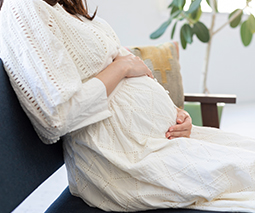Placenta praevia: What you need to know about the signs, treatment and risks

Bleeding in pregnancy can be terrifying but there are plenty of reasons why this might occur and one of those is placenta praevia. We speak to an expert to find out more about symptoms, treatments and how the condition can affect a birth plan.
What is placenta praevia?
It involves the placenta implanting partly or completely over the cervix, which can block the baby’s path for a vaginal birth. While it needs to be taken very seriously, in most cases both mum and bub come through it without complications.
What are the risks?
Dr Vicki Nott from the Melbourne City Obstetrics Gynaecology tells Babyology expectant mums with placenta praevia are considered a high risk pregnancy and will be closely monitored.
In cases where the placenta completely blocks or closely borders the cervix at the time of delivery, bub will most likely need to be born via a c-section. This is due to the risk of extreme bleeding from the placenta as the cervix dilates. “A placenta praevia is more likely to have bleeding and that can be both at the time of the caesarian or at any time in the later part of the pregnancy,” Dr Nott says.
While the chief risk of blood loss is to the mother it can also impact bub. “The main risk is to the mum but of course if the mum suffers a big enough blood loss then she’ll stop providing blood to the baby as well,” she adds. “If the mum is bleeding so heavily and doctors can’t stop it, even if she is only 28 weeks, they will have to do a caesarian, so then the baby suffers the risks of prematurity.”
Is it treatable?
Dr Nott says there is no treatment to stop or prevent placenta praevia. “You can’t do anything about it, you just try and make sure the mum takes her iron so her blood count is as good as possible just in case she does bleed,” Dr Nott says.
“Quite a lot of people at the 20 week scan have a low placenta and usually we just do another scan at 32 weeks because most of them [placentas] will have moved out of the way. The problem is the ones that are low and stay low.”
Don’t panic
Dr Nott says most women with placenta praevia go on to deliver without complication. “It is nearly always a good outcome. The risk of bleeding is not high and you would always warn the mum after they have their 20 week scan, that if they have any bleeding they should come to hospital,” she warns.
“It is usually painless, bright red bleeding and if someone has just a little bit of bleeding, you might just watch them more closely. If they have a moderate amount of bleeding, they might have to stay in hospital for one or two weeks and sometimes, if they keep bleeding, they might have to have their baby prematurely because the only treatment is caesarean.
Continue daily life as normal
Placenta praevia doesn’t have to impact an expectant mum’s daily routine. “You can go about your normal job or daily activity and if you have any bleeding you report it straight away,” Dr Nott says.
“If it is a spot or two that’s okay, report it, but anything heavier than that and you will have to come to hospital straight away to get checked out. It’s probably also wise to plan that you may have to leave work early and you will definitely have to have a caesarian section.”
What you need to know
Every case is different and women need to follow the advice of their individual doctors but here are some of the recommendations Dr Nott says women with placenta praevia will most likely receive.
Avoid sex
“Generally we would advise them not to have sex because you don’t want to do anything that prods the cervix.”
No internal examinations
“Usually doctors won’t do an internal examination once they know about the placenta praevia on a scan.”
Stay close to hospital
“We would probably say don’t go off to a remote area and stay relatively close to the hospital so if there is an emergency you can get there quickly.”
Placenta praevia should be painless
“There is a completely different problem called an abruption that can cause pain and bleeding, but usually with a placenta praevia it is painless bleeding.”









